Special Sets: The Swim Training of Crile Hart, Kenyon’s Two-Time Division III Swimmer of the Year
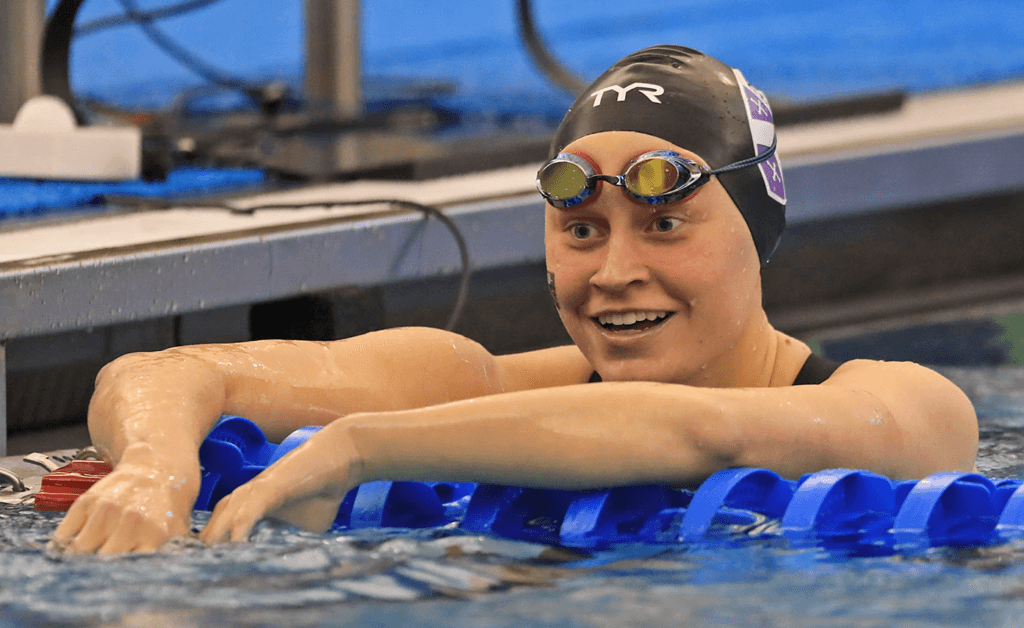
Special Sets: The Swim Training of Crile Hart, Kenyon’s Two-Time Division III Swimmer of the Year (Archive)
This month’s “Special Sets” focuses on two-time NCAA Division III Swimmer of the Year Crile Hart of Kenyon College, which won this year’s team championships. Sample practices are provided by Coach Jessen Book.
All is right with the world again in Gambier, Ohio…at least with the 24-time national—and latest—women’s NCAA D-III swimming champion Kenyon. This year’s NCAA championship win over 10-time reigning national champion Emory provided a fitting coda for two-time D-III CSCAA Swimmer of the Year Crile Hart. “My heart, mind and body with the sport of swimming feels good,” says Hart. “It feels at peace. It feels whole. It was probably the best ending I could have imagined and written for my swimming career.”
Let’s see how that career started. Hart swam for hall of fame coach Jerry Holtrey, who coached her at the Hawken School in Gates Mills, Ohio, and the Lake Erie Silver Dolphins. In high school, Hart was an 11-time state champion and 11-time NISCA All-American. She was the first Buckeye State D-II swimmer to go under 2:00 in the 200 yard IM. Out of high school, she was the second-ranked female in Ohio (and 59th nationally) in the Class of 2017.
Fast forward to Kenyon, where Hart began a stellar career that was partially disrupted by COVID. The anthropology major (art minor) finished as a 14-time national champion (eight individual, six relays—in just three years of championship meets) and a 28-time CSCAA All-American. Five of those individual titles came in the 100 and 200 back, the others in the 200 IM (2) and 100 fly.
Not wanting to close her career without a final national meet, Hart took a gap year (2020-21) and helped propel the Ladies to the national title after finishing second to Emory the previous three years the NCAA Championship meet was contested.
She ended her time in Gambier holding three individual school records: 100 free (49.51), 200 back (1:55.67) and 200 IM (1:57.76). She also resides on four school relay-record quartets: 200 medley (1:39.59), 400 medley (3:38.05), 200 free (1:30.39) and 400 free (3:20.05).
BOOK TRAINING HART
At Kenyon, Coach Jessen Book found Hart to be “an amazing person. She was definitely the type of athlete who would have been welcomed on a competitive D-I roster. In her college search, I believe she was looking for a place that spoke to her—not for ‘what it could be,’ but for what it was. She found that in Kenyon, and has been an incredible fit from the start.
“When I think of Crile, I think of a woman who takes a simple joy in the water. I think about someone who:
• is playful at practices, but also serious and driven at meets
• competes for those around her—her family, her friends and her team
• exudes love and trust, and
• races to win
“She is the most selfless competitor I’ve ever worked with,” says Book. “She wanted to win, but not for herself—for everyone she loved. However, in practices at Kenyon, Crile was never the fastest—which I think is also a great lesson. Frequently, she would find herself at the back of the lane. She would always give a great effort, but often that effort didn’t reflect itself in the times/places you would expect from someone with her accolades.
“But—and this is super important—that didn’t bother her. Each day, each practice, each set was treated simply: Try hard, be present, connect with those around you, and then move on when done. Practices were not predictors for Crile. They were places to connect with what—and who—she loved.”
HART TRAINING HART
“I love what I do—swimming and being surrounded by friends, coaches and the water itself. I feel challenged and uplifted by all three, and I just have fun training or racing. I never really had ‘an approach’ to workouts,” says Hart. “I just try to love what I do and do what I love! I would get in each day and truly push myself during practice, lifting or racing, always with a pep in my step, a smile on my face or a joke in hand.
“To me, pushing oneself harder than the previous practice, week or season—all while having fun—is the perfect combination for success and improvement! I have discovered that there is an extra competitive edge that comes out when competing, which is why I may not necessarily hit normally expected training times 100% of the time…but that never deterred me from my love of—and dedication to—the sport, my team, my training and happiness,” she says.
Following are three practices Book asked his team to do. The first is from the 2019-20 season, where Hart was seeded first at NCAAs in six events at the end of the qualifying period. “Sadly, we didn’t have an NCAA Championships that season,” says Book. The second is from the fall of 2021, and the third from the lead-up to the 2022 national championships.
Hart recalls several memorable sets at Kenyon that advanced her training and annealed her competitive spirit. “One challenging set we did each year after our training trip was 8 x 200 from the blocks fast, best average, no cool-down in between, a few minutes in between each effort. I would alternate one IM and one back, but most people would stick to one stroke. Practicing 200 race strategy when you’re tired is a great way to train for your races. It was a super gutsy set,” she says.
“A second set that was challenging, but one that I enjoyed for backstroke work, was 20 x 50 200 pace on a minute. Once you were off your pace for two 50s in a row, you would sit out a 50, then jump back in. Many repeat 50s pace are rough, but I found them extremely helpful.
“Two other things that made me feel stronger in the water were improving my pull-up strength and doing three underwater focused practices a week, working on distance underwater, dolphin kick, breath holding endurance and technique. Those definitely made me a more confident and stronger racer.”
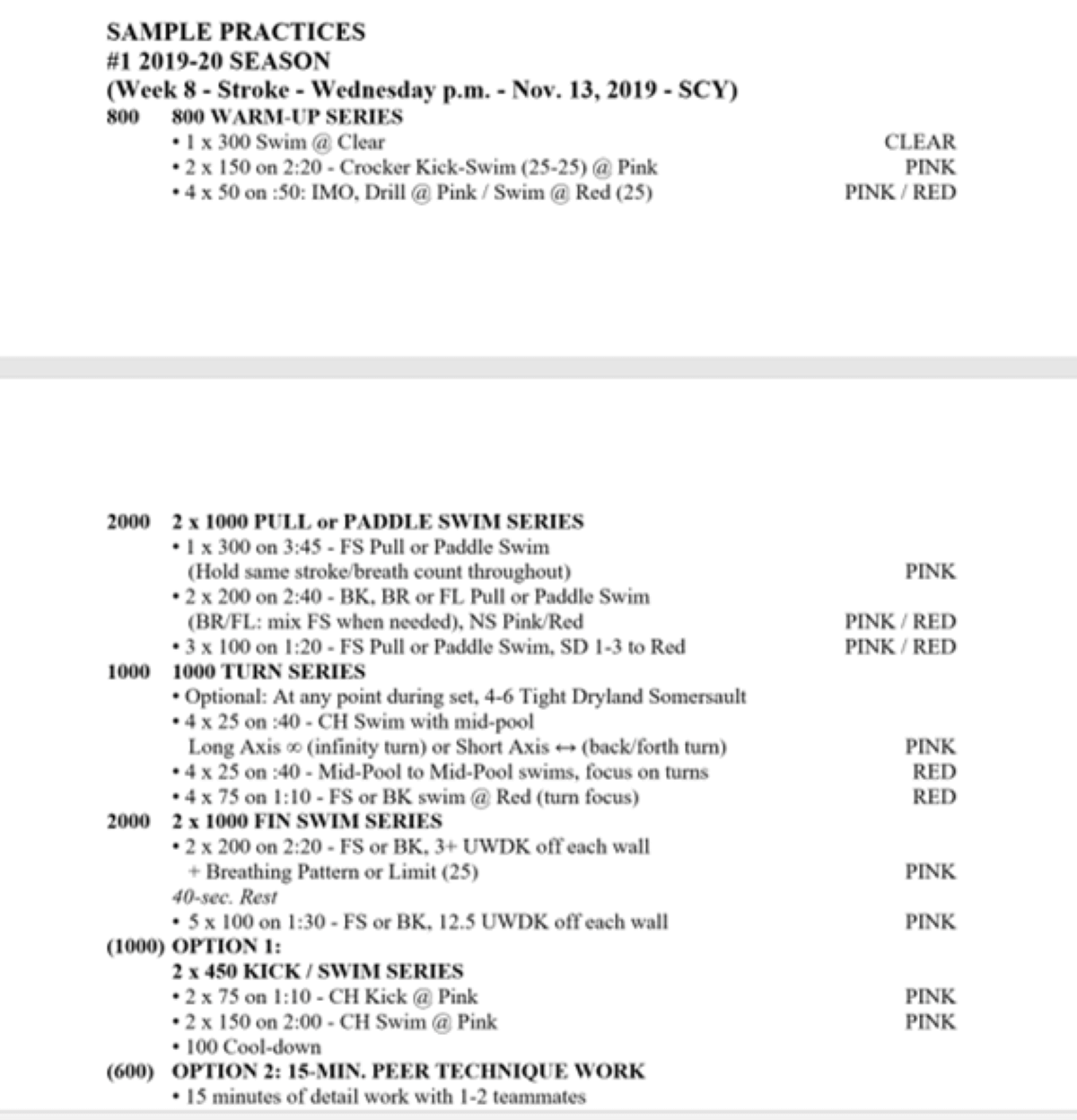
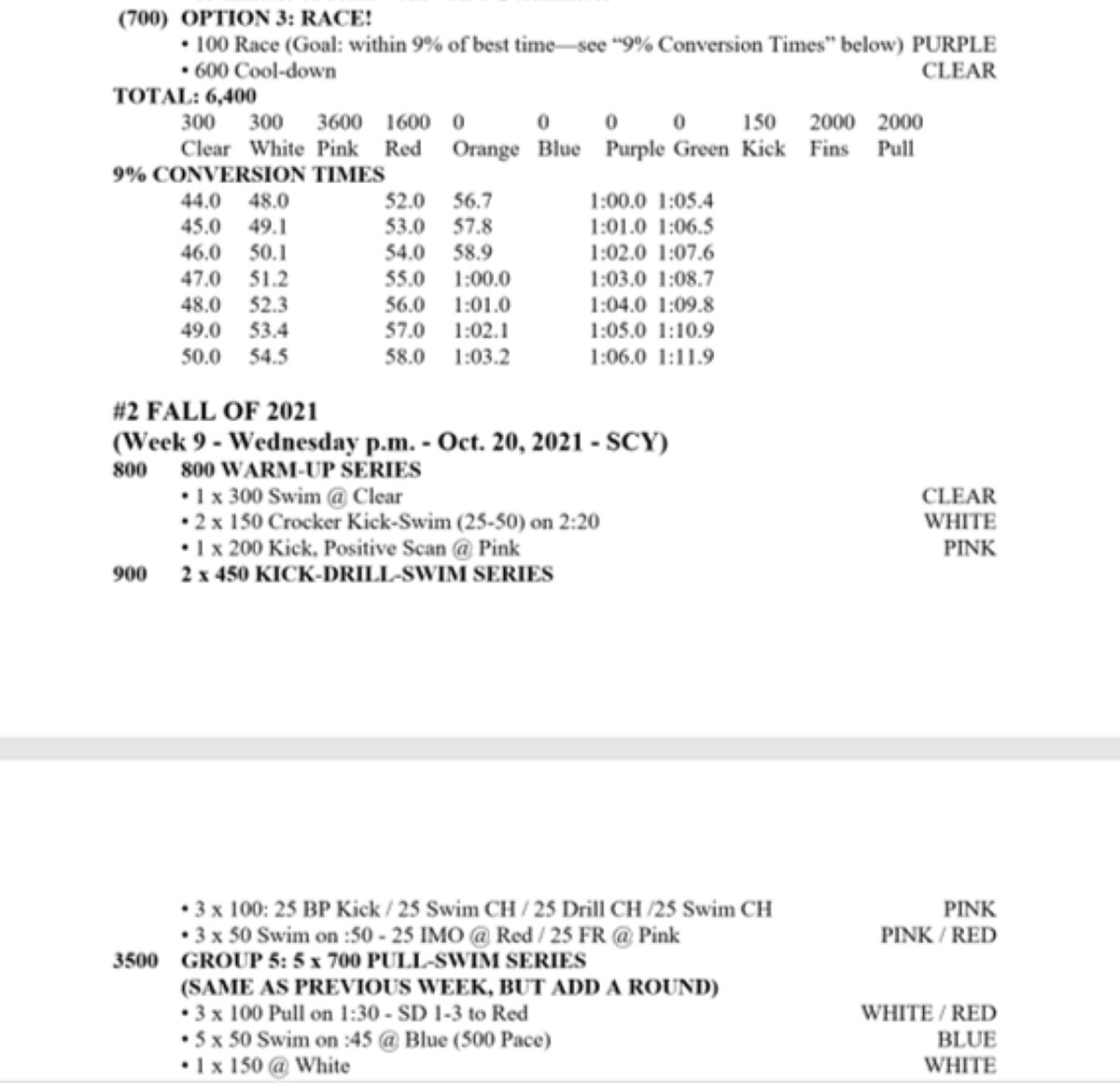
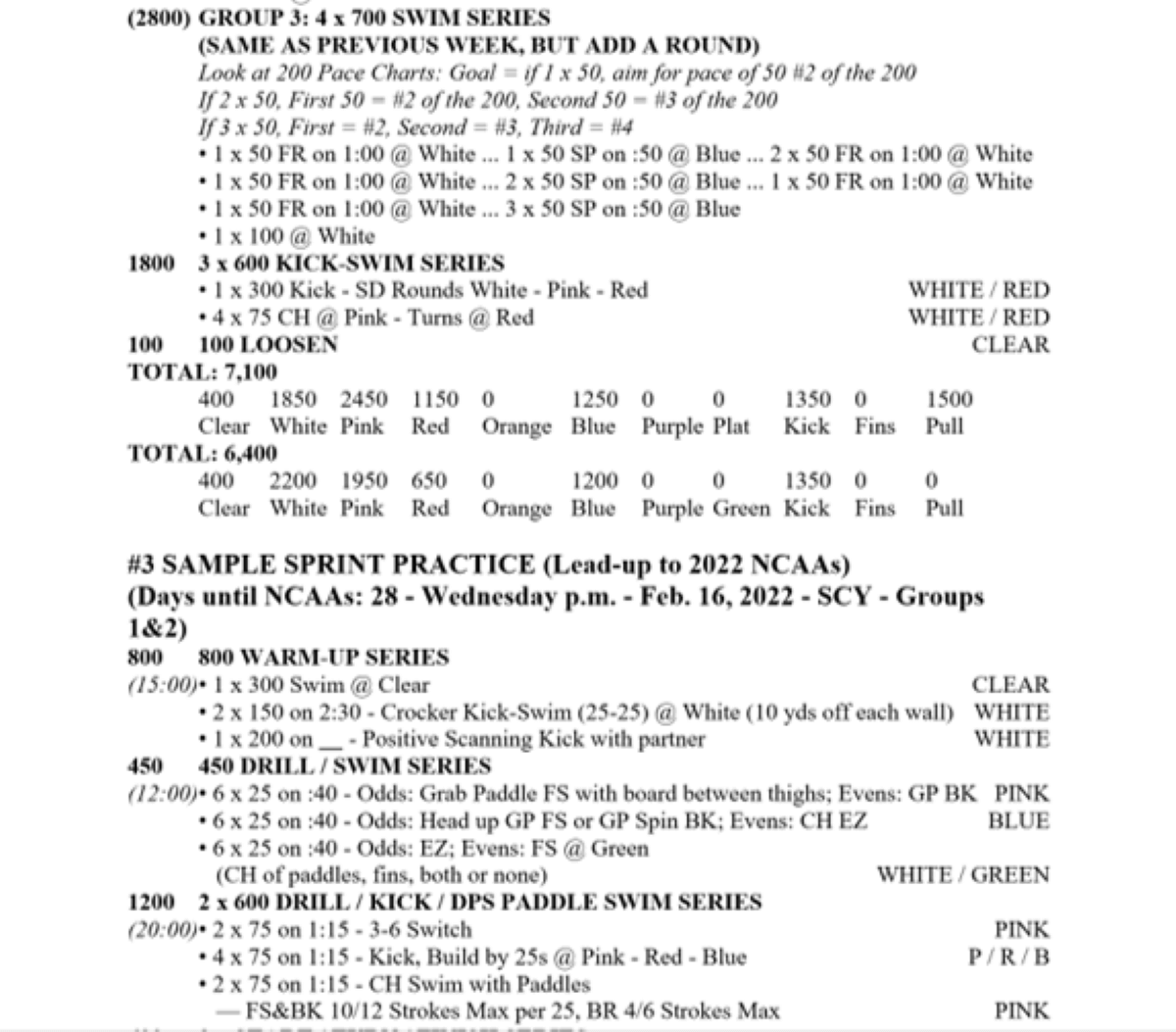
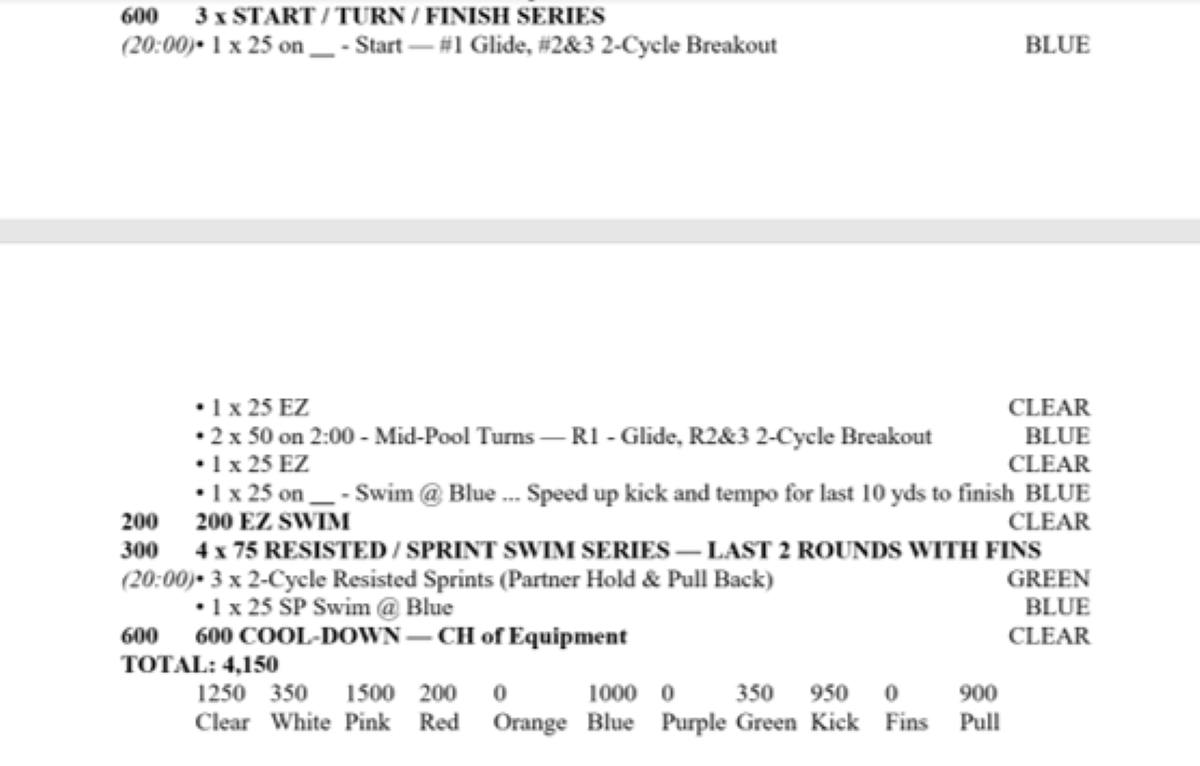




What do the colors mean?
Energy systems. Jon Urbanchek came up with the idea to color code effort levels / energy systems to differentiate between a hard effort that’s aerobic vs anaerobic and easy/mod/etc.